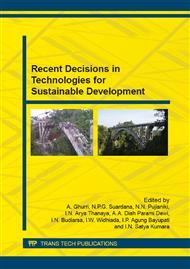p.3
p.9
p.17
p.24
p.30
p.36
p.41
p.47
Properties of Sand Sheet Asphalt Mixture Incorporating Waste Plastic
Abstract:
Construction of road pavement requires large amount of materials. Effort to incorporate secondary or lower quality materials had been done. This is particularly attractive for constructing lower trafficked road. Within this experiments waste polypropylene (PP) plastic was used as partial aggregate substitute in sand sheet asphalt mixture, with objective to evaluate its properties. The amount of plastic used was 10%, 20%, and 30%. The aggregate and plastic were proportioned. The aggregate were heated to around 155-160 °C, then pre-melted asphalt and the waste plastic were added then re-mixed until the asphalt evenly coat the materials. The mixture was compacted at 2x50 Marshall blows. It was found that at 8.5% optimum asphalt content, and at all range of plastic content the stability was 277.41-283.49 kg (> 200kg), Void in Mixture within range (3-6%), Void in Mineral Aggregate >20% and Void Filled with Bitumen >75%, all met the Indonesian specification. However the flows were > max 3mm and Marshall Quotient < min 80 kg/mm (did not specification). When incorporating plastic, only limited amount of plastic (less than 10%) can be incorporated to meet the specification.
Info:
Periodical:
Pages:
9-16
Citation:
Online since:
July 2015
Authors:
Keywords:
Price:
Сopyright:
© 2015 Trans Tech Publications Ltd. All Rights Reserved
Share:
Citation:


